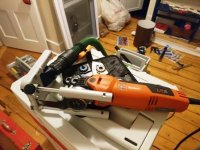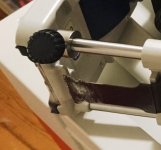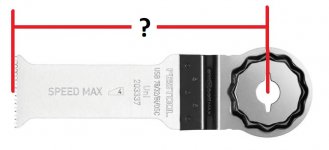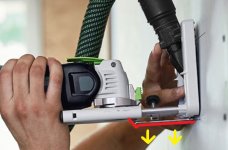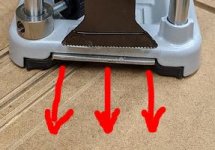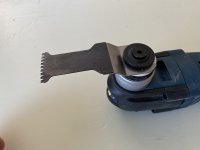[member=65062]DynaGlide[/member] - Thanks for following up on this!
Looking back at photos from an earlier project, I found this:
[attachimg=1]
[attachimg=2]
I recall in the above instance that the only thing I had to do was to adjust the magnet such that it grabbed the blade as it passed - this was enough to allow the shorter blade to cut plumb to the travel of the plunge base. In my case, I was cutting along a pencil line into sheetrock and the plunge cuts were perfect. Of course, maybe if the material in question is less forgiving (like what you were working with) accuracy will suffer. Is this what you found?
Funny how not knowing something is often all one needs to know to "just get on with it". I didn't know any better and I didn't suffer any ill-effects from using the plunge base with an "unapproved" blade. Go figure.
Also, I could see this 'short-blade workaround' potentially not working with a short blade that features a coated tip - like the Fein diamond blade (63502193210) I recently picked up for a spring cement siding repair job - since the built-up edge of the cutting surface is ever so slightly thicker than the rest of the blade. In that case, I suppose it's possible that the coated diamond or carbide tip would not clear the magnet and chew it up in the process.
That said, I think that as long as one takes this limitation into account, use of the plunge base with blades shorter than the non-Multimaster-compatible Starlock Max 203337 blade is perfectly doable (that is, as long as one doesn't need to achieve the max depth afforded by that extra long blade - in which case it would appear to be the only option).
[following some quick research] By the way, both Fein and Bosch make a variety of super-long Starlock Max blades (like the Fein 63502203260, for instance, which appears to be the Fein-branded version of the Festool 203337 or the Bosch OSM200F which appears to be quite similar). Bosch even makes super-long Starlock Max blades with carbide tips (like the Bosch OSM114C).
You know, it just dawned me, but the one thing that defines Starlock Max blades (and makes them unique among all the other Starlock Plus and Starlock blade offerings) is their super long length (a little late to the party, I know). So, no matter what, if the desire is to utilize a blade that contacts the adjustable magnet in the plunge base
before any action is taken to compress the springs inside the plunge base, then one cannot use this accessory in conjunction with a Multimaster. Good to know. Of course, as I already pointed out, I didn't experience any problems from doing so, so it definitely appears to be an option (the most obvious workaround, as you've already pointed out, is to slowly actuate the plunge base until the magnet grabs the blade and then proceed as normal).
All that said, now I'm wondering if the plunge base can be modified in order to, in-effect, "choke" the uncompressed-end of its travel. I'll have to look into this. I would think that anyone who owns an OSC or the corded or cordless Fein-branded comparables (those which can be successfully fitted with the OSC accessory mounting collar) would like the flexibility of being able to use the plunge base as intended along with far less expensive Starlock Plus blades. I know I certainly would.
Thanks again.







